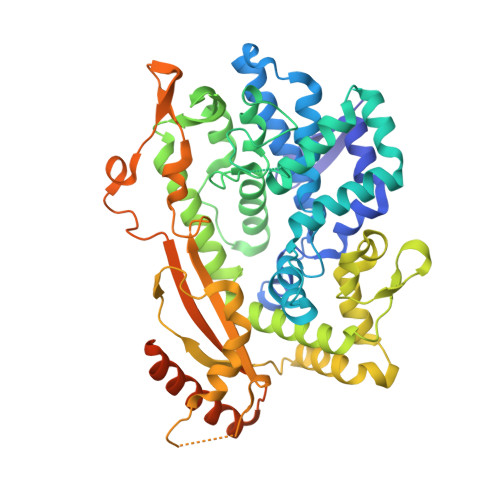Impaired dNTPase Activity of SAMHD1 by Phosphomimetic Mutation of Thr-592.
Tang, C., Ji, X., Wu, L., Xiong, Y.(2015) J Biol Chem 290: 26352-26359
- PubMed: 26294762
- DOI: https://doi.org/10.1074/jbc.M115.677435
- Primary Citation of Related Structures:
4ZWE, 4ZWG - PubMed Abstract:
SAMHD1 is a cellular protein that plays key roles in HIV-1 restriction and regulation of cellular dNTP levels. Mutations in SAMHD1 are also implicated in the pathogenesis of chronic lymphocytic leukemia and Aicardi-Goutières syndrome. The anti-HIV-1 activity of SAMHD1 is negatively modulated by phosphorylation at residue Thr-592. The mechanism underlying the effect of phosphorylation on anti-HIV-1 activity remains unclear. SAMHD1 forms tetramers that possess deoxyribonucleotide triphosphate triphosphohydrolase (dNTPase) activity, which is allosterically controlled by the combined action of GTP and all four dNTPs. Here we demonstrate that the phosphomimetic mutation T592E reduces the stability of the SAMHD1 tetramer and the dNTPase activity of the enzyme. To better understand the underlying mechanisms, we determined the crystal structures of SAMHD1 variants T592E and T592V. Although the neutral substitution T592V does not perturb the structure, the charged T592E induces large conformational changes, likely triggered by electrostatic repulsion from a distinct negatively charged environment surrounding Thr-592. The phosphomimetic mutation results in a significant decrease in the population of active SAMHD1 tetramers, and hence the dNTPase activity is substantially decreased. These results provide a mechanistic understanding of how SAMHD1 phosphorylation at residue Thr-592 may modulate its cellular and antiviral functions.
Organizational Affiliation:
From the Department of Molecular Biophysics and Biochemistry, Yale University, New Haven, Connecticut 06520 and.

















